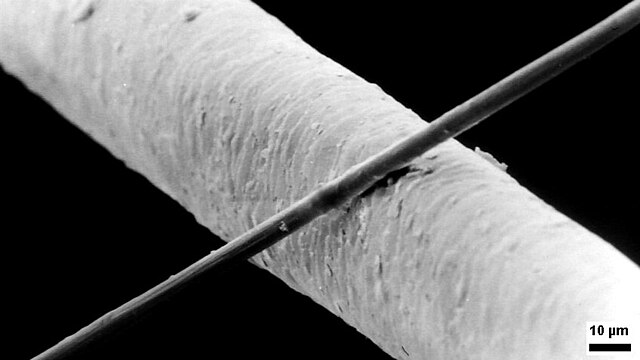Composite material: Difference between revisions - Wikipedia
 Article Images
Article Images
Content deleted Content added
MrOllie 229,519 edits |
|||
| (15 intermediate revisions by 15 users not shown) | |||
Line 9: *[[Reinforced plastic]]s, such as [[fibre-reinforced polymer]] or [[fiberglass]] *[[Ceramic matrix composite]]s ([[composite armor|composite ceramic and metal matrices]]) *[[Metal matrix composite]]s<ref>Zhou, M. Y., et al. "Progress in research on hybrid metal matrix composites." Journal of Alloys and Compounds 838 (2020): 155274. *and other [[advanced composite materials (engineering)|advanced composite materials]] There are various reasons where new material can be favoured. Typical examples include materials which are less expensive, lighter, stronger or more durable when compared with common materials, as well as composite materials inspired from animals and natural sources with low carbon footprint.<ref>{{cite journal |last1=Nepal |first1=Dhriti |last2=Kang |first2=Saewon |last3=Adstedt |first3=Katarina M. |last4=Kanhaiya |first4=Krishan |last5=Bockstaller |first5=Michael R. |last6=Brinson |first6=L. Catherine |last7=Buehler |first7=Markus J. |last8=Coveney |first8=Peter V. |last9=Dayal |first9=Kaushik |last10=El-Awady |first10=Jaafar A. |last11=Henderson |first11=Luke C. |author12-link=David L. Kaplan (engineer) |last12=Kaplan |first12=David L. |last13=Keten |first13=Sinan |last14=Kotov |first14=Nicholas A. |last15=Schatz |first15=George C. |date=2022-11-28 |title=Hierarchically structured bioinspired nanocomposites |url=https://www.nature.com/articles/s41563-022-01384-1 |journal=Nature Materials |volume=22 |issue=1 |pages=18–35 |language=en |doi=10.1038/s41563-022-01384-1 |pmid=36446962 |s2cid=254094123 |issn=1476-1122 |access-date=2022-12-12 |archive-date=2022-12-12 |archive-url=https://web.archive.org/web/20221212012711/https://www.nature.com/articles/s41563-022-01384-1 |url-status=live}}</ref> Line 22: The earliest composite materials were made from [[straw]] and [[mud]] combined to form [[brick]]s for [[building]] [[construction]]. Ancient [[brick#Mud bricks|brick-making]] was documented by [[Art of Ancient Egypt#Painting|Egyptian tomb paintings]].<ref name=Haka>{{cite book |first=Andreas |last=Haka |title=Engineered Stability.The History of Composite Materials |location=Cham |publisher=Springer 2023 Chap. 1 on "Early composites".}}</ref> [[Wattle and daub]] is one of the oldest composite materials, at over 6000 years old.<ref name=Shaffer>{{cite journal |last=Shaffer |first=Gary D. |title=An Archaeomagnetic Study of a Wattle and Daub Building Collapse |journal=Journal of Field Archaeology |volume=20 |number=1 |date=Spring 1993 |pages=59–75 |doi=10.2307/530354 |jstor=530354}}</ref> Concrete is also a composite material, and is used more than any other synthetic material in the world. {{as of| * Woody [[plant]]s, both true [[wood]] from [[trees]] and such plants as [[palm (plant)|palms]] and [[bamboo]], yield natural composites that were used prehistorically by humankind and are still used widely in construction and scaffolding. * [[Plywood]], 3400 BC,<ref name="auto">{{cite web |url= * [[Cartonnage]], layers of [[linen]] or [[papyrus]] soaked in plaster dates to the [[First Intermediate Period of Egypt]] c. 2181–2055 BC<ref name="auto"/> and was used for [[death mask]]s. * [[Cob (material)|Cob]] mud bricks, or mud walls, (using mud (clay) with straw or gravel as a binder) have been used for thousands of years.<ref>{{cite web |url=https://expandusceramics.com/qa/is-cob-a-composite.html |title=Is Cob A Composite? |access-date=2020-12-19 |website=expandusceramics.com |date=27 August 2019 |archive-date=2021-05-23 |archive-url=https://web.archive.org/web/20210523201857/https://expandusceramics.com/qa/is-cob-a-composite.html |url-status=live}}</ref> Line 51 ⟶ 53: Composites can also use metal fibres reinforcing other metals, as in [[metal matrix composite]]s (MMC)<ref>{{cite web |title=7: Metal Matrix Composites {{!}} School of Materials Science and Engineering|url=http://www.materials.unsw.edu.au/tutorials/online-tutorials/7-metal-matrix-composites|access-date=2020-12-17|website=www.materials.unsw.edu.au|archive-date=2021-01-25|archive-url=https://web.archive.org/web/20210125180839/http://www.materials.unsw.edu.au/tutorials/online-tutorials/7-metal-matrix-composites|url-status=live}}</ref> or [[ceramic matrix composite]]s (CMC),<ref>{{cite web |last1=L |last2=Co |first2=L. Special Furnace |last3=L |first3=Inc |last4=Co |first4=L. Special Furnace |last5=Aston |first5=Inc 20 Kent Road |last6=Pa 19014 877.846.7628 |date=2018-08-30 |title=What are Ceramic Matrix Composites? |url=https://llfurnace.com/blog/what-are-ceramic-matrix-composites/ |access-date=2020-12-17 |website=L&L Special Furnace Co, Inc. |archive-date=2020-09-28 |archive-url=https://web.archive.org/web/20200928172733/https://llfurnace.com/blog/what-are-ceramic-matrix-composites/ |url-status=live}}</ref> which includes [[bone mineral|bone]] ([[hydroxyapatite]] reinforced with [[collagen]] fibres), [[cermet]] (ceramic and metal), and [[concrete]]. Ceramic matrix composites are built primarily for [[fracture toughness]], not for strength. Another class of composite materials involve woven fabric composite consisting of longitudinal and transverse laced yarns. Woven fabric composites are flexible as they are in form of fabric. Organic matrix/ceramic aggregate composites include [[asphalt concrete]], [[polymer concrete]], [[mastic asphalt]], mastic roller hybrid, [[dental composite]], [[syntactic foam]], and [[nacre|mother of pearl]].<ref>{{cite web |title=Composite Material |url=https://www.hi-techindia.in/composite-material |access-date=2020-12-21 |website=hi-techindia |language=en |archive-date=2021-03-03 |archive-url=https://web.archive.org/web/20210303031856/https://www.hi-techindia.in/composite-material |url-status=live}}</ref> [[Chobham armour]] is a special type of [[composite armour]] used in military applications.{{ Additionally, [[thermoplastic]] composite materials can be formulated with specific metal powders resulting in materials with a density range from 2 g/cm<sup>3</sup> to 11 g/cm<sup>3</sup> (same density as lead). The most common name for this type of material is "high gravity compound" (HGC), although "lead replacement" is also used. These materials can be used in place of traditional materials such as aluminium, stainless steel, brass, bronze, copper, lead, and even tungsten in weighting, balancing (for example, modifying the centre of gravity of a tennis [[racquet]]), vibration damping, and radiation shielding applications. High density composites are an economically viable option when certain materials are deemed hazardous and are banned (such as lead) or when secondary operations costs (such as machining, finishing, or coating) are a factor.<ref>{{cite web |date=2001-02-15 |title=Thermoplastic Composites - An Introduction |url=https://www.azom.com/article.aspx?ArticleID=85 |access-date=2020-12-17 |website=AZoM.com |language=en |archive-date=2012-04-05 |archive-url=https://web.archive.org/web/20120405141717/https://www.azom.com/article.aspx?ArticleID=85 |url-status=live}}</ref> Line 200 ⟶ 202: where <math>\sigma</math> is the stress, <math>\epsilon</math> is the strain, E is the [[elastic modulus]], and V is the [[volume fraction]]. The subscripts c, f, and m are indicating composite, fiber, and matrix, respectively. After passing the elastic region for both fiber and the matrix, the second region of the stress–strain curve :<math>\sigma_c = V_f E_f \epsilon_c + V_m \sigma_m (\epsilon_c)</math> Line 744 ⟶ 746: ===Failure=== Shock, impact of varying speed, or repeated cyclic stresses can provoke the laminate to separate at the interface between two layers, a condition known as [[delamination]].<ref>{{Cite journal |last=Ma |first=Binlin |last2=Cao |first2=Xiaofei |last3=Feng |first3=Yu |last4=Song |first4=Yujian |last5=Yang |first5=Fei |last6=Li |first6=Ying |last7=Zhang |first7=Deyue |last8=Wang |first8=Yipeng |last9=He |first9=Yuting |date=2024-02-15 |title=A comparative study on the low velocity impact behavior of UD, woven, and hybrid UD/woven FRP composite laminates |url=https://doi.org/10.1016/j.compositesb.2023.111133 |journal=Composites Part B: Engineering |volume=271 |pages=111133 |doi=10.1016/j.compositesb.2023.111133 |issn=1359-8368}}</ref><ref>{{Cite journal |last=Sanchez-Saez |first=S. |last2=Barbero |first2=E. |last3=Zaera |first3=R. |last4=Navarro |first4=C. |date=2005-10-01 |title=Compression after impact of thin composite laminates |url=https://doi.org/10.1016/j.compscitech.2005.04.009 |journal=Composites Science and Technology |volume=65 |issue=13 |pages=1911–1919 |doi=10.1016/j.compscitech.2005.04.009 |issn=0266-3538|hdl=10016/7498 |hdl-access=free }}</ref> Individual fibres can separate from the matrix, for example, [[fiber pull-out|fibre pull-out]].
Composites can fail on the [[macroscopic]] or [[microscopic]] scale. Compression failures can happen at both the macro scale or at each individual reinforcing fibre in compression buckling. Tension failures can be net section failures of the part or degradation of the composite at a microscopic scale where one or more of the layers in the composite fail in tension of the matrix or failure of the bond between the matrix and fibres. Line 776 ⟶ 778: ==See also== * [[3D composites]] * [[Aluminium composite panel]] * [[American Composites Manufacturers Association]] | |||